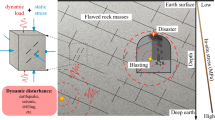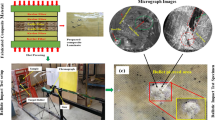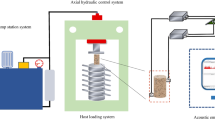Abstract
With the aim of simulating the real conditions during the navigation, in this framework, impact tests were performed by loading CFRP laminates immersed in the water from the front side. The specimens, made by vinyl ester matrix because of the lower moisture absorption compared to the other epoxy systems, are in the presence of the water to accurately simulate the incidental impact on the hull of the vessel, immersed or partially immersed, during the navigation. It can be caused by the ice in the Arctic Ocean, by a projectile due to a terroristic attack or by debris from an explosion. The results are compared with the ones obtained by loading the laminates in pure traditional impact tests in the air. The influence of the clamping device has been tested too. The exciting results obtained on carbon fiber laminates in the air (pure traditional impact tests), water-backed (with water on the back side) and waterfront (water only on the front side) conditions at room temperature are here reported and compared. They highlighted the critical role played by the complex fluid–structure interaction.
















Similar content being viewed by others
References
G. Caprino and V. Lopresto, The Significance of Indentation in the Inspection of Carbon Fibre-Reinforced Plastic Panels Damaged by Low-Velocity Impact, Compos. Sci. Technol., 2000, 60, p 1003–1012
V. Lopresto, A. Langella, and I. Papa, Dynamic Load on Composite Laminates in the Presence of Water, Polym. Eng. Sci., 2017, 57(6), p 613–620
V. Lopresto, I. Papa, and A. Langella, Residual Strength Evaluation After Impact Tests in Extreme Temperature Conditions: New Equipment for CAI, Tests, Compos. B Eng., 2017, 127, p 44–52
G. Caprino, Residual Strength Prediction of Impacted CFRP Laminates, J. Compos. Mater., 1984, 18(6), p 508–518
G. Caprino, Residual Strength Prediction of Impacted CFRP Laminates, J. Compos. Mater., 1984, 18, p 508–518
G. Caprino, V. Lopresto, C. Scarponi, and G. Briotti, Influence of Material Thickness on the Response of Carbon-Fabric/Epoxy Panels to Low-Velocity Impact, Compos. Sci. Technol., 1999, 59, p 2279–2286
F.K. Chang, H.Y. Choi, and H.S. Wang, Damage of laminated composites due to low-velocity impact, in 31st AIAA/ASME/ASCE/AHS/ASC Structures, Structural Dynamics and Materials Conference, Long Beach, CA, April 2–4, pp. 930–940, 1990
A.J. Lesser and A.G. Filippov, Kinetics of Damage Mechanisms in Laminated Composites, Int. SAMPE Symp. Exhib., 1991, 36(Part 1), p 886–900
E.F. Dost, L.B. Ilcewitz, and W.B. Avery, Effects of stacking sequence on impact damage resistance and residual strength for quasi-isotropic laminates, in ASTM STP 1110, T. K. O’Brien Ed., pp. 476–500, 1991
H.Y. Choi and F.K. Chang, A Model for Predicting Damage in Graphite/Epoxy Laminated Composites Resulting from Low-Velocity Point Impact, J. Compos. Mater., 1992, 26(14), p 2134–2169
S. Liu, Z. Kutlu, and F.K. Chang, Matrix Cracking and Delamination Propagation in Laminated Composites Subjected to Transversely Concentrated Loading, J. Compos. Mater., 1993, 27(5), p 436–470
S. Abrate, Impact on Laminated Composites: Recent Advances, Appl. Mech. Rev., 1994, 47(11), p 517–544
Y. Shindo, S. Ueda, and Y. Nishioka, Mechanical Behaviour of Woven Composites at Low Temperatures, Fusion Eng. Des., 1993, 20(C), p 469–474
M.G. Kim, S.G. Kang, C.G. Kim, and C.W. Kong, Tensile Response of Graphite/Epoxy Composites at Low Temperatures, Compos. Struct., 2007, 79(1), p 84–89
Y. Sefrani and J.M. Berthelot, Temperature Effect on the Damping Properties of Unidirectional Glass Fibre Composites, Compos. B Eng., 2006, 37(4–5), p 346–355
A. Khalid, Mater. Des., 2006, 27, p 499
M. Howard and L. Hollaway, The Characterization of the Non-linear Viscoelastic Properties of a Randomly Orientated Fibre/Matrix Composite, Composites, 1987, 18(4), p 317–323
Y.W. Kwon, A.C. Owens, A.S. Kwon, and J.M. Didoszak, Experimental Study of Impact on Composite Plates with Fluid–Structure Interaction, Int. J. Multiphys., 2010, 4(3), p 259–271
Y.W. Kwon and A.C. Owens, Dynamic Responses of Composite Structures with Fluid–Structure Interaction, in Advances in Composite Materials, IN-TECH publisher, 2011
G. Busse, Optoacoustic Phase Angle Measurement for Probing a Metal, Appl. Phys. Lett., 1979, 35, p 759–760
Y.W. Kwon, Low-Velocity Impact on Polymer Composite Plates in Contact with Water, Int. J. Multiphys., 2012, 6(3), p 179–197
Y.W. Kwon and M.A. Violette, Damage Initiation and Growth in Laminated Polymer Composite Plates with fluid-Structure Interaction Under Impact Loading, Int. J. Multiphys., 2012, 6(1), p 29–42
V. Lopresto and G. Caprino, Damage Mechanisms and Energy Absorption in Composite Laminates Under Low-Velocity Impact Loads, Solid Mech. Its Appl., 2013, 192, p 209–289
S. Timoshenko and S. Woinowsky-Krieger, Theory of Plates and Shells, 2nd ed., McGraw-Hill, New York, 1959
A. Shams, V. Lopresto, and M. Porfiri, Modeling Fluid–Structure Interactions During Impact Loading of Water-Backed Panels, Compos. Struct., 2017, 171, p 576–590
Acknowledgments
The authors gratefully acknowledge the ONR Solid Mechanics Program, in the person of Dr. Yapa D. S. Rajapakse, Program Manager, for the financial support provided to this research.
Author information
Authors and Affiliations
Corresponding author
Additional information
Publisher's Note
Springer Nature remains neutral with regard to jurisdictional claims in published maps and institutional affiliations.
This article is an invited submission to JMEP selected from presentations at the International Symposium on Dynamic Response and Failure of Composite Materials (Draf2018) held June 12–15, 2018, on the Island of Ischia, Italy, and has been expanded from the original presentation.
Rights and permissions
About this article
Cite this article
Lopresto, V., Langella, A. & Papa, I. Interaction of Water with Carbon Fiber Reinforced Polymer Laminates under Dynamic Loading Conditions. J. of Materi Eng and Perform 28, 3220–3227 (2019). https://doi.org/10.1007/s11665-019-03915-5
Received:
Revised:
Published:
Issue Date:
DOI: https://doi.org/10.1007/s11665-019-03915-5




